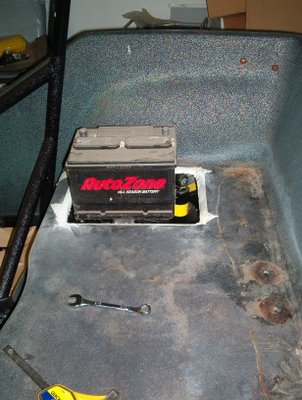Final fabrication....I hope.
This last week I did, what I hope, will be the final Fabrication of any steel that might be on my car. I made a rear support out of two inch angled steel. This will be to support my battery and any other stuff that I might put in the rear of the car. Before I could fab the support, I had to cut out the recessed portion of the fiberglass in the rear of the car. I did this because the bottom was already cut out and also because my pan is IRS. These kits were originally designed for a swing axle car that didn't have the trailing arms my car does. If I was to leave the box recessed, my suspension would be hitting the bottom of the battery tray. My plan is to enclose the back and make it a trunk to house my battery, speakers, and for storage. I might even run my fuse panel back there as well. I think it will be easier to access for maintenance rather than installing it under the dash. The support runs from one shock tower to the other with M10 bolts installed where the Beetle body was originally bolted.



I also had to fab two brackets for the front of the car to support the fuel tank and fenders. These are bolted to the front beam and run up to where the tank will bolt in as well. I already had brackets welded to the beam in order to install my front bumper.

When I was done with all the steel fabrication. I threw everything together for a test fit in order to make sure it was all going to work. I must say...This thing is starting to look like a car.



SWEET!
This week I plan to make to windshield backing plates and get some fiberglass work done. I should have all my engine parts by next week and have the thing bolted up with any luck.
By the way, if you ever need a windshield for any of theses cars, call Dino. He will make you one for a custom fit. He did mine and I couldn't be happier. They say he makes all the windshields for the manufacturers of buggies out there anyway. You might as well go straight to the source.
Bug Shields by Dino
Dean Burdett
(714) 854-0519





